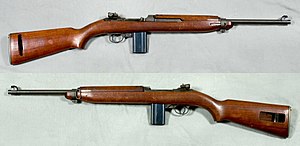M1 Carbine
| Carbine, Caliber .30, M1 | |
|---|---|

M1 Carbine
|
|
| Type |
|
| Place of origin | United States |
| Service history | |
| In service | July 1942–1973 (United States) |
| Used by | See Users |
| Wars |
World War II Hukbalahap Rebellion Malayan Emergency Suez Crisis Korean War Cuban Revolution First Indochina War Vietnam War The Troubles Cambodian Civil War Angolan Civil War Mexican Drug War |
| Production history | |
| Designer | Frederick L. Humeston William C. Roemer David Marshall Williams |
| Designed | 1938–41 |
| Manufacturer |
Military contractors Commercial copies |
| Unit cost | $45 (WW2) |
| Produced | 1941—present |
| Number built | Over 6.5 million |
| Variants | M1A1, M1A3, M2, M2A2, M3 |
| Specifications | |
| Weight |
5.2 lb (2.4 kg) empty 5.8 lb (2.6 kg) loaded w/ sling |
| Length | 35.6 in (900 mm) |
| Barrel length | 18 in (460 mm) |
|
|
|
| Cartridge | .30 Carbine |
| Action | Gas-operated (short-stroke piston), rotating bolt |
| Rate of fire |
Semi-automatic (M1/A1) 750 rounds/min (M2) |
| Muzzle velocity | 1,990 ft/s (607 m/s) |
| Effective firing range | 300 yd (270 m) |
| Feed system | 15- or 30-round detachable box magazine |
| Sights | Rear sight: aperture; L-type flip or adjustable, front sight: wing-protected post |
5.2 lb (2.4 kg) empty
The M1 carbine (formally the United States Carbine, Caliber .30, M1) is a lightweight, easy to use,.30 caliber semi-automatic carbine that was a standard firearm for the U.S. military during World War II, the Korean War and well into the Vietnam War. The M1 carbine was produced in several variants and was widely used by not only the U.S. military, but by military, paramilitary and police forces around the world. It has also been a popular civilian firearm.
The M2 carbine is the selective-fire version of the M1 carbine capable of firing in both semi-automatic and full-automatic. The M3 carbine was an M2 carbine with an active infrared scope system.
Despite its name and similar appearance, the M1 carbine is not a shorter version of the M1 Garand rifle. It is a completely different firearm and it fires a different type of ammunition. It was simply called a carbine because it is smaller and lighter than the Garand.
On July 1, 1925, the U.S. Army began using the current naming system where the "M" is the designation for Model and the "number" represents the sequential development of equipment and weapons. Therefore, the "M1 rifle" was the first rifle developed under this system. The "M1 carbine" was the first carbine developed under this system. The "M2 carbine" was the second carbine developed under the system, etc.
Prior to World War II, U.S. Army Ordnance received reports that the full-size M1 rifle was too heavy and cumbersome for most support troops (staff, mortarmen, radiomen, etc.) to carry. During prewar and early war field exercises, it was found that the M1 Garand impeded these soldier's mobility, as a slung rifle would frequently catch on brush, bang the helmet, or tilt over the eyes. Many soldiers found the rifle slid off the shoulder unless slung diagonally across the back, where it prevented the wearing of standard field packs and haversacks.
...
Wikipedia
